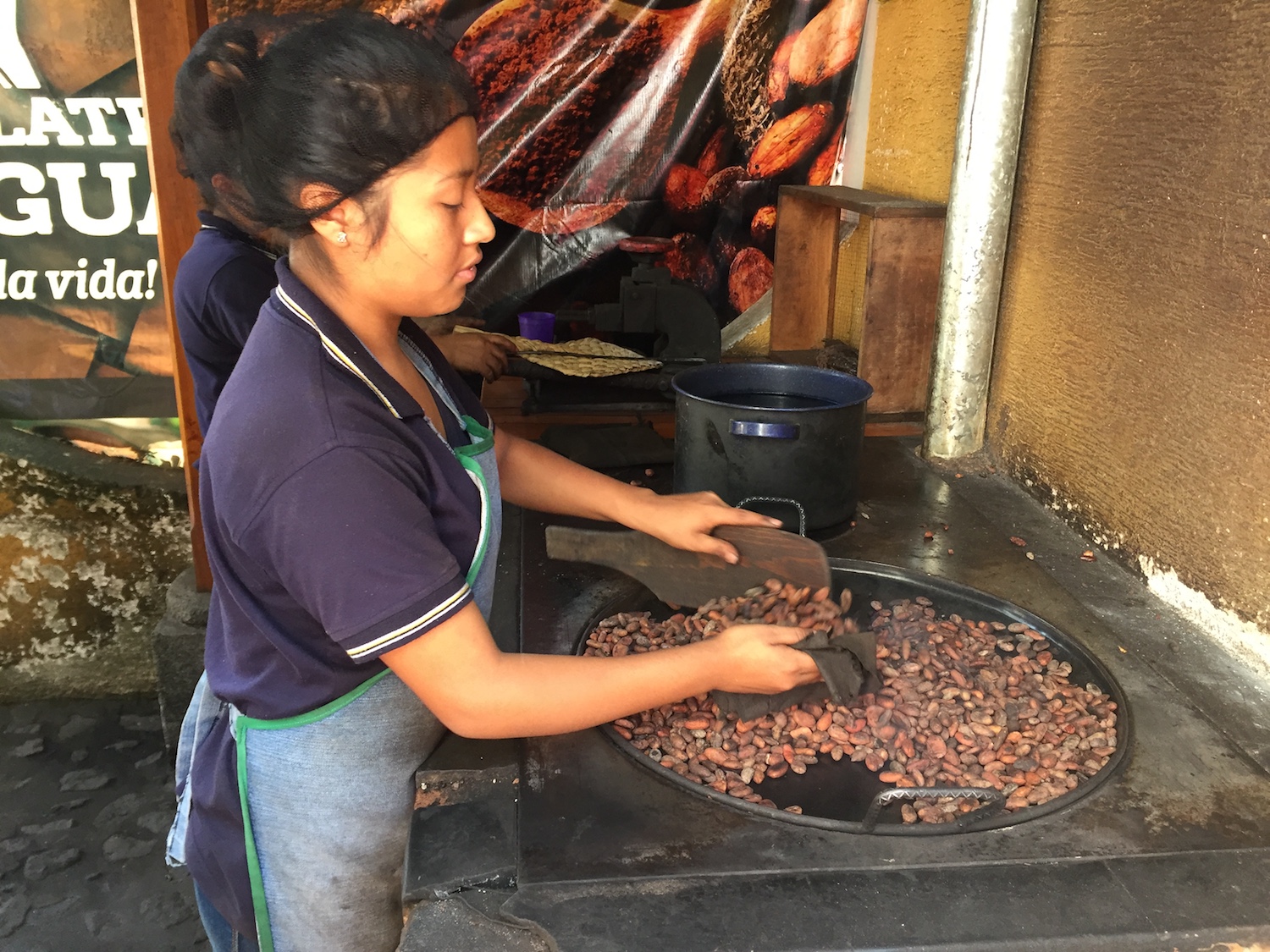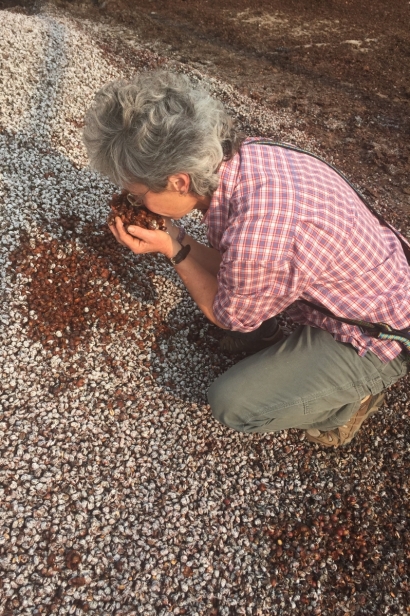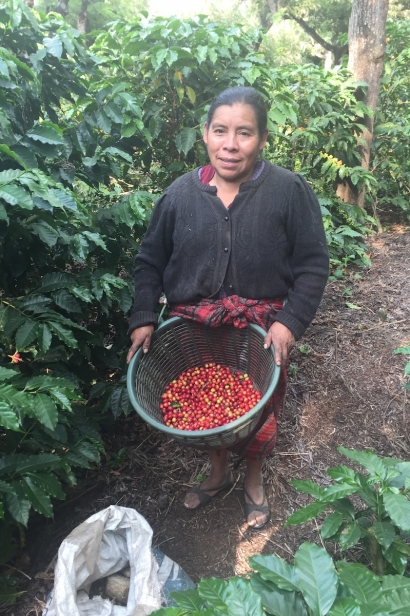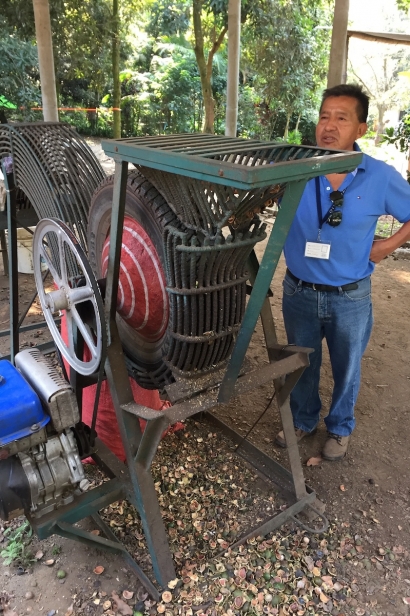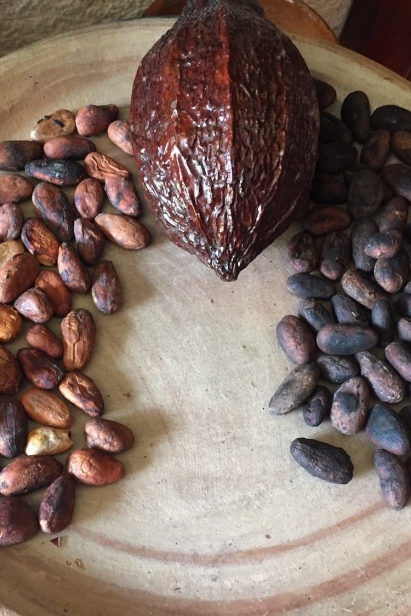Guatemala: Six Centuries of Innovative Agriculture
Wood smoke, grilled meat, roast coffee. Motor scooters buzz along cobblestone streets, Spanish music from dark interiors, church bells toll the quarter hours. Single-story buildings painted terra cotta, saffron, azure, peach. Red tile roofs, heavy wooden doors propped open to reveal lush garden courtyards with strings of festive lighting and burbling fountains. Exotic flowers in pink, red, deep purple attract a multitude of tropical birds.
Floating notes dance from wooden flutes. Women in traditional Mayan garb, layers of brilliant woven shawls and skirts, embroidered tops. Street vendors’ arms draped with necklaces and bracelets of jade, glass, silver and leather. Jingle of bell as a teenager pushes a cart filled with helados, slices of frozen mango, papaya, watermelon, pineapple, melon.
Last year in November, I traveled to Guatemala to attend the wedding of my niece Ali, who has worked there for the past five years. The wedding took place during Thanksgiving week. With brilliant days and cool nights, it took me about a minute to acclimate to my new surroundings in Antigua, an hour from Guatemala City.
My husband, Ned, and I tumbled out of the taxi around 10pm. Twenty minutes later, we were sipping mojitos and swabbing fresh tortilla chips through just-made guacamole. Shots of añejo tequila appeared as family members welcomed these two jet-lagged travelers to the week of festivities.
In between family events, I did what any self-respecting farmer does on a vacation: visit farms. We exchanged handshakes with our guide, Fausto, and he did a double-take. “So you work the land?” With that knowledge, he pivoted from his standard tourist itinerary. “I will show you the real Guatemala.” Here’s what I learned.
Shade-Grown Coffee
Our first stop was an off-the-beaten-track coffee plantation high in the mountains above Antigua. Not native to Guatemala, coffee was introduced as a crop in the mid-1800s. Guatemala is now the sixth-largest coffee producer in the world, second in quality only to Ethiopia. Coffee had been Guatemala’s primary income until 2012; the main revenues now are paybacks (Guatemalans working in the United States sending money to family back home), coffee and tourism.
Coffee needs water and shade. Guatemala’s rainy season runs May through October and the dry season from November to April. Coffee grows best under the shade of the grevillea, a tree brought from Australia in the 1840s. These tall grevilleas, interspersed through the long rows of coffee bushes, protect the tender fruit from burning in the intense sunlight. The trees are shaped and pruned with machetes every year to allow just enough light to fall on the younger coffee bushes. Smaller plantations often use fruit trees such as orange, lime, avocado and banana, which provide both shade and a crop.
The best beans grow at high altitude—café altura—1,500 to 2,000 meters, or 5,000 to 6,500 feet. Antigua sits at 1,500 meters, and most plantations are located high in the hills outside of town. Common varieties of beans include arabica, bourbon and robusta. The harvest occurs from December to March, and it takes up to five sessions for Mayan women and children to harvest the crop by hand as the berries ripen in stages, much like cherry tomatoes. In fact, the fruit of a coffee plant is called a “cherry,” for its bright-red color and sweet flesh. The bitterness evolves after the fruity pulp is removed and the bean is dried and roasted. Coffee beans are spread across large swaths of concrete to dry in the sun; beans are raked and turned to prevent spoilage. This drying can take up to several weeks depending on climate. All of these steps, from harvest to drying and packing, are done by hand. Keep that in mind the next time you raise your eyebrows at beans that sell for $15 a pound.
Nuts About Macadamias
The Valhalla Macadamia Farm began 35 years ago as a mission-driven experiment. Lorenzo Gottschamer, a retired firefighter and environmentalist from California, had traveled to Guatemala for two weeks of backpacking but fell in love with the country and a woman he met, Emilia Aguirre. Together they built this organic farm which has evolved into an experimental permaculture station and wellness spa that promotes macadamia-based skin care products including soaps, creams, salves and extracts. Macadamia oil is a natural moisturizer, providing nutrients and oleic acids to keep skin vibrant.
Gottschamer saw the wisdom of macadamia cultivation as a sustainable alternative crop to coffee. His thinking? A coffee bush lives for 25 to 30 years, whereas a macadamia tree thrives for 150. Coffee is harvested once a year while macadamia trees produce nuts year-round, as the wind drops the hard shells to the ground. Thus the nuts provide a steady source of income and a comparatively easy harvest. Moreover, macadamia trees require minimal fertilizer and don’t deplete the soil.
Only three places grow macadamia nuts: Australia, Hawaii and Guatemala. Macadamia flourish in Guatemala’s acidic soil, as do blueberries, Gottschamer’s other primary interest. He has been heavily invested in developing extensive blueberry farms in the northern mountains.
For the past 20 years, Gottschamer has donated thousands of macadamia saplings and helped plant 350,000 trees around the country. He generated this initiative specifically to bring economic independence to indigenous Mayan families, widows in particular, and to help the environment.
Valhalla Macadamia Farm has no electricity. Every aspect of the low-tech operation, from composting toilets to gravity-fed water, runs naturally or through funky Rube Goldberg contraptions such as a nutcracker/husker powered by an old lawn mower engine. The discarded shells are composted and reapplied to the soil or used for pathways.
Farmers' Market, Guatemalan Style
Alex Kronick, a Guatemalan, founded Caoba Farms in 2004, taking over three acres once dedicated to cultivating coffee and roses. His operation expanded to 45 acres that now grow more than 100 varieties of organic produce, largely destined for top restaurants and hotels in Antigua and Guatemala City. Central to this sustainable closed-loop ecosystem are the chickens, ducks, rabbits, sheep and pigs which provide fertility for the soil.
Located a 15-minute walk from the center of Antigua, Caoba Farms hosts a fiesta, or farmers’ market, every Saturday. The emphasis leans toward organic foods and indigenous artisanal handcrafts. My favorite stall was Tinte Maya, a women’s cooperative of weavers who make functional-chic bags, scarves and shawls using natural dyes from local plants. Every sale goes directly to the women weavers. The community farm also offers tours of the lush gardens, permaculture courses and plenty of volunteer opportunities.
At the heart of the farm is the open-air Caoba Café, run by two Australians named Annie and Felix. Think shade cloth, banana trees, cedar shavings pathways. A pair of musicians strum guitars and croon mellow tunes in Spanish. Lounge chairs covered in woven fabric and burlap coffee bags offer a place to kick back and sip an ice-cold beer or tropical fruit drink while waiting for your thin-crust pizza, veggiecentric egg dish, just-harvested salad or grilled sourdough sandwich. Another option is the Ríncon Típico, adjacent to one of the gardens, which serves typical Guatemalan dishes, such as pepián, chicken stew, tamales and tostados, made right on the wood-fired grills.
I spent two days meandering with Fausto, a patient and knowledgeable guide. We also visited a family who produces artisanal chocolates from local cacao. Because of its size and terrain, Guatemala remains unsullied by factory farms, which accounts for the high-quality, largely organic food. Most labor is done by hand with rudimentary hoes, machetes and wheelbarrows; tractors could never maneuver the patchwork fi elds and terraced gardens sown into the rugged volcanic hillsides.
As more countries around the globe grow coffee, the price declines. In Guatemala, pineapples, mangoes, flowers (poinsettias, orchids, indigo and asters), macadamia nuts and blueberries now provide sustainable alternatives. Other crops include corn, dry beans, squash, potatoes and avocados as well as peanuts and cacao.
While it’s painful to see Taco Bell, Papa John’s and McDonald’s in the heart of Antigua, I was elated to discover Antigua Brewing Company, established 2015. The hazy juicy IPA I enjoyed there one evening rivaled the best in New England. And my niece’s wedding, held amid the ruins of a 16th-century cathedral, was a gracious bilingual merging of two cultures. Travel in the 21st century reminds us of our similarities rather than our differences.
The Valhalla Macadamia Farm
Caoba Farms | @caobafarms
Caoba Café
Ríncon Típico
Antigua Brewing Company | @antiguabrewing_co


